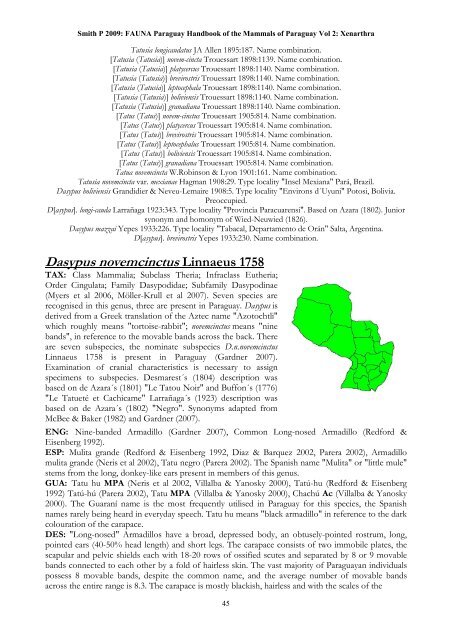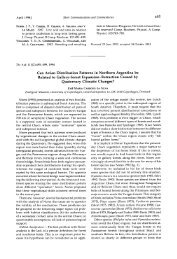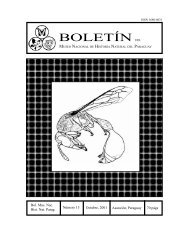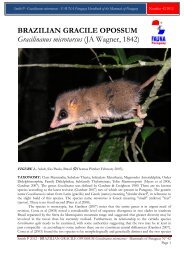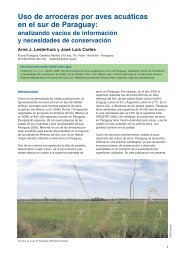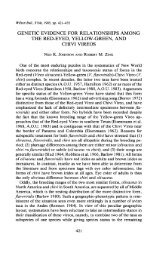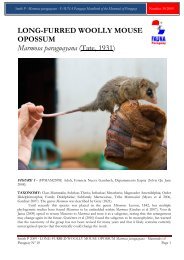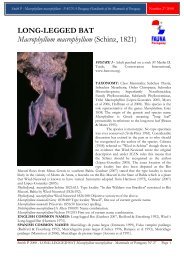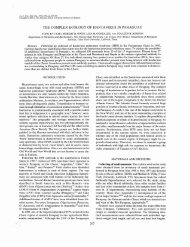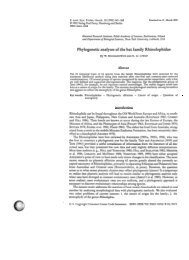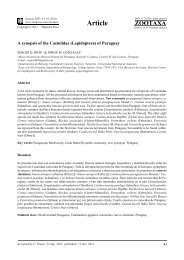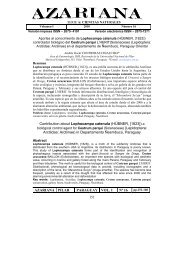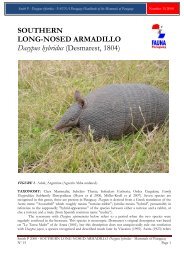hbk mammals vol 2 - FAUNA Paraguay
hbk mammals vol 2 - FAUNA Paraguay
hbk mammals vol 2 - FAUNA Paraguay
Create successful ePaper yourself
Turn your PDF publications into a flip-book with our unique Google optimized e-Paper software.
Smith P 2009: <strong>FAUNA</strong> <strong>Paraguay</strong> Handbook of the Mammals of <strong>Paraguay</strong> Vol 2: Xenarthra<br />
Tatusia longicaudatus JA Allen 1895:187. Name combination.<br />
[Tatusia (Tatusia)] novem-cincta Trouessart 1898:1139. Name combination.<br />
[Tatusia (Tatusia)] platycercus Trouessart 1898:1140. Name combination.<br />
[Tatusia (Tatusia)] brevirostris Trouessart 1898:1140. Name combination.<br />
[Tatusia (Tatusia)] leptocephala Trouessart 1898:1140. Name combination.<br />
[Tatusia (Tatusia)] boliviensis Trouessart 1898:1140. Name combination.<br />
[Tatusia (Tatusia)] granadiana Trouessart 1898:1140. Name combination.<br />
[Tatus (Tatus)] novem-cinctus Trouessart 1905:814. Name combination.<br />
[Tatus (Tatus)] platycercus Trouessart 1905:814. Name combination.<br />
[Tatus (Tatus)] brevirostris Trouessart 1905:814. Name combination.<br />
[Tatus (Tatus)] leptocephalus Trouessart 1905:814. Name combination.<br />
[Tatus (Tatus)] boliviensis Trouessart 1905:814. Name combination.<br />
[Tatus (Tatus)] granadiana Trouessart 1905:814. Name combination.<br />
Tatua novemcincta W.Robinson & Lyon 1901:161. Name combination.<br />
Tatusia novemcincta var. mexianae Hagman 1908:29. Type locality "Insel Mexiana" Pará, Brazil.<br />
Dasypus boliviensis Grandidier & Neveu-Lemaire 1908:5. Type locality "Environs d´Uyuni" Potosi, Bolivia.<br />
Preoccupied.<br />
D[asypus]. longi-cauda Larrañaga 1923:343. Type locality "Provincia Paracuarensi". Based on Azara (1802). Junior<br />
synonym and homonym of Wied-Neuwied (1826).<br />
Dasypus mazzai Yepes 1933:226. Type locality "Tabacal, Departamento de Orán" Salta, Argentina.<br />
D[asypus]. brevirostris Yepes 1933:230. Name combination.<br />
Dasypus novemcinctus Linnaeus 1758<br />
TAX: Class Mammalia; Subclass Theria; Infraclass Eutheria;<br />
Order Cingulata; Family Dasypodidae; Subfamily Dasypodinae<br />
(Myers et al 2006, Möller-Krull et al 2007). Seven species are<br />
recognised in this genus, three are present in <strong>Paraguay</strong>. Dasypus is<br />
derived from a Greek translation of the Aztec name "Azotochtli"<br />
which roughly means "tortoise-rabbit"; novemcinctus means "nine<br />
bands", in reference to the movable bands across the back. There<br />
are seven subspecies, the nominate subspecies D.n.novemcinctus<br />
Linnaeus 1758 is present in <strong>Paraguay</strong> (Gardner 2007).<br />
Examination of cranial characteristics is necessary to assign<br />
specimens to subspecies. Desmarest´s (1804) description was<br />
based on de Azara´s (1801) "Le Tatou Noir" and Buffon´s (1776)<br />
"Le Tatueté et Cachicame" Larrañaga´s (1923) description was<br />
based on de Azara´s (1802) "Negro". Synonyms adapted from<br />
McBee & Baker (1982) and Gardner (2007).<br />
ENG: Nine-banded Armadillo (Gardner 2007), Common Long-nosed Armadillo (Redford &<br />
Eisenberg 1992).<br />
ESP: Mulita grande (Redford & Eisenberg 1992, Diaz & Barquez 2002, Parera 2002), Armadillo<br />
mulita grande (Neris et al 2002), Tatu negro (Parera 2002). The Spanish name "Mulita" or "little mule"<br />
stems from the long, donkey-like ears present in members of this genus.<br />
GUA: Tatu hu MPA (Neris et al 2002, Villalba & Yanosky 2000), Tatú-hu (Redford & Eisenberg<br />
1992) Tatú-hú (Parera 2002), Tatu MPA (Villalba & Yanosky 2000), Chachú Ac (Villalba & Yanosky<br />
2000). The Guaraní name is the most frequently utilised in <strong>Paraguay</strong> for this species, the Spanish<br />
names rarely being heard in everyday speech. Tatu hu means "black armadillo" in reference to the dark<br />
colouration of the carapace.<br />
DES: "Long-nosed" Armadillos have a broad, depressed body, an obtusely-pointed rostrum, long,<br />
pointed ears (40-50% head length) and short legs. The carapace consists of two immobile plates, the<br />
scapular and pelvic shields each with 18-20 rows of ossified scutes and separated by 8 or 9 movable<br />
bands connected to each other by a fold of hairless skin. The vast majority of <strong>Paraguay</strong>an individuals<br />
possess 8 movable bands, despite the common name, and the average number of movable bands<br />
across the entire range is 8.3. The carapace is mostly blackish, hairless and with the scales of the<br />
45


